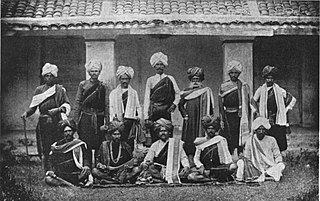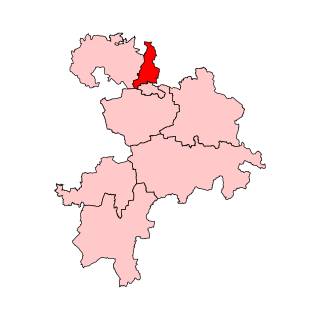Related Research Articles
The Nagarathar is a Tamil caste found native in Tamil Nadu, India. They are a Tamil mercantile community who are traditionally involved in commerce, banking and money lending.

Gobichettipalayam is a town and municipality in Erode district of the Indian state of Tamil Nadu. It is the administrative headquarters of Gobichettipalayam taluk. It is situated at the center of the South Indian Peninsula at 213 metres (699 ft) above sea level, surrounded by Western Ghats. It is located 35 kilometres (22 mi) from the district headquarters Erode, 44 kilometres (27 mi) from Tiruppur and 80 kilometres (50 mi) from Coimbatore. Agriculture and textile industries contribute majorly to the economy of the town.
Kaarkaathaar is a subcaste of Vellalar Hindu caste in the Indian state of Tamil Nadu.
Mudaliar is a Tamil title and surname. As title, it was historically given to high-ranking military officers and their descendants during the Chola empire rule. The surname is most prevalent among Tamils from Tamil Nadu and Sri Lanka. Descendants of Tamil colonial migrants also bears variants of the name in countries such as South Africa, and elsewhere in the Tamil diaspora.

Vokkaliga is a community of closely related castes, from the Indian states of Karnataka and Tamil Nadu.
Vellalar is a group of castes in the Indian states of Tamil Nadu, Kerala and northeastern parts of Sri Lanka. The Vellalar are members of several endogamous castes such as the numerically strong Arunattu Vellalar, Chozhia Vellalar, Karkarthar Vellalar, Kongu Vellalar, Thuluva Vellalar and Sri Lankan Vellalar.
Kongu Vellalar is a community found in the Kongu region of Tamil Nadu, India.
Thuluva Vellalar, also known as Agamudaya Mudaliars and Arcot Mudaliars, is a caste found in northern Tamil Nadu, southern Andhra Pradesh and southern Karnataka. They were originally significant landowners.

Anthiyur is a legislative assembly, that includes the town, Anthiyur and other neighbouring local bodies. Its State Assembly Constituency number is 105. It is a part of the Tiruppur Lok Sabha constituency. The constituency is in existence since 1962 election. Anthiyur was a part of Gobichettipalayam Lok Sabha constituency until 2009 election. It is one of the 234 State Legislative Assembly Constituencies in Tamil Nadu.

Karur is a state assembly constituency in Karur district in Tamil Nadu. Its State Assembly Constituency number is 135. It comes under Karur Lok Sabha constituency. It is one of the 234 State Legislative Assembly Constituencies in Tamil Nadu, in India.

Sangagiri or 'Sankari' is a state assembly constituency in Salem district, Tamil Nadu, India. Its State Assembly Constituency number is 87. It comprises Sangagiri taluk and a portion of Omalur taluk. It is a part of the wider Namakkal constituency for national elections to the Parliament of India. Elections and winners in the constituency are listed below. The constituency is in existence since 1957 election. It is one of the 234 State Legislative Assembly Constituencies in Tamil Nadu, in India.

Perundurai is a state assembly constituency in Erode district in Tamil Nadu. Its State Assembly Constituency number is 103. It covers Perundurai and some parts of Erode City. It is included in Tiruppur Lok Sabha constituency. The constituency is in existence since 1957 election. It is one of the 234 State Legislative Assembly Constituencies in Tamil Nadu, in India.

The Kunchitigas are a community of people from Karnataka, India. They are mostly concentrated in the Tumkur, Bangalore, Mysore, Ramanagara, Shivamogga and Chitradurga districts. They are also found in Tamil Nadu.

Tiruppur North or 'Tiruppur (North)' is a state assembly constituency in Tiruppur district in Tamil Nadu, India newly formed after constituency delimitations 2008. Its State Assembly Constituency number is 113. It is included in the Tiruppur parliamentary constituency. Tiruppur North will be one of 17 assembly constituencies to have VVPAT facility with EVMs in 2016 Tamil Nadu Legislative Assembly election. It is one of the 234 State Legislative Assembly Constituencies in Tamil Nadu, in India.
Kongu Vellala Goundergal Peravai is a caste organization in the Indian state of Tamil Nadu. It exists for the Kongu Vellalar Gounder or Vellala Gounder community.

Kurumba Gounder is a community from South India, especially the state of Tamil Nadu.
Kalingarayan was a chieftain who ruled in the Kongu Nadu region of the present day Western Tamil Nadu in 13th century CE.
Thondaimandala Vellalar is a high-ranking subcaste of the Vellalar caste in the state of Tamil Nadu, India who tend, to adopt the title of Mudaliar and they were traditional "landlords and officials of the state class" described by the anthropologist Kathleen Gough. They are a closely knit community and follow the Vegetarian diet. Thondaimandalam Mudaliars / Vellalars are progressive and prosperous in the society and they are remarkably advanced in the matter of education
Nankudi Vellalar, is a Tamil sub caste of Vellalar found in Tamil Nadu, India. They claim descent from the Velir clan of Irungovels The hereditary headman of the caste was always invested with the title Irungovel. Their original stronghold seems to have been southern districts of Tamil Nadu, viz. Thoothukudi, Tirunelveli, Korkai, Ambasamudram, etc. Some of them migrated to Srivaikuntam during the course of time and came to be known as Kottai Vellalar or Kottai Pillaimar as they built and lived in forts.
References
- ↑ "Gounder consolidation could pose headache to major parties". The Times of India . 21 May 2009. Archived from the original on 4 November 2012.
- 1 2 List of subcastes (PDF) (Report). Government of Tamil Nadu. Retrieved 1 November 2023.
- 1 2 Haswell, M. R. (2013), "Dusi (North Arcot District)", Econ Dev Village India Ils 59, Routledge, pp. 32–39, doi:10.4324/9781315888736, ISBN 978-1-315-88873-6
- ↑ Evans, Harold (12 October 2004). They made America : From the steam engine to the search engine. Little, Brown. ISBN 0-316-27766-5. OCLC 999370982.
- ↑ Chennakrishnaiah, Shilpa (2011). Analysis of Y-chromosome Diversity in Lingayat and Vokkaliga Populations of Southern India (Thesis). Florida International University. doi: 10.25148/etd.fi11072506 .
- ↑ Madhvan, Karthik (2 August 2008). "Steeped in history". Frontline. Chennai, India: The Hindu Group. Archived from the original on 3 December 2013. Retrieved 22 January 2011.
- ↑ Sadasivan, S. N (2000). A social history of India. New Delhi, India: APH Pub. Corp. p. 254. ISBN 9788176481700. Archived from the original on 18 March 2023. Retrieved 17 November 2021.
In all probability the Tamil Kavandans or Goundans might have branched of from them and both might be descendants of Kurumbas of yore.
- ↑ Basu, Raj Sekhar (2011). Nandanar's Children: The Paraiyans' Tryst with Destiny, Tamil Nadu 1850 - 1956. SAGE. p. 137. ISBN 978-81-321-0679-1.